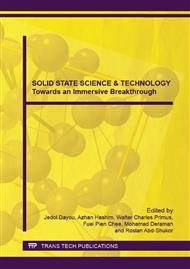[1]
F. Caruso, Nanoengineering of particle surfaces, Advanced Material. 13 (2001) 11-22.
Google Scholar
[2]
M.S. Niasari, F. Davar and N. Mir, Synthesis and characterization of metallic copper nanoparticles via thermal decomposition, Polyhedron. 27 (2008) 3514-3518.
DOI: 10.1016/j.poly.2008.08.020
Google Scholar
[3]
L.C. Soare, P. Bowen, J. Lemaitre, H. Hofmann, Precipitation of nanostructured copper oxalate: substructure and growth mechanism, Journal of Physical Chemistry B. 110 (2006) 17763-17771.
DOI: 10.1021/jp0606816
Google Scholar
[4]
X. Zhang, D. Zhang, X. Ni, H. Zheng, Optical and electrochemical properties of nanosized CuO via thermal decomposition of copper oxalate, Solid-State Electronics. 52 (2008) 245-248.
DOI: 10.1016/j.sse.2007.08.009
Google Scholar
[5]
M. Vaseem, A. Umar, S.H. Kim, Y. Hahn, Low-temperature synthesis of flower-shaped CuO nanostructures by solution process: formation mechanism and structural properties, Journal of Physical Chemistry C. 112 (2008) 5729-5735.
DOI: 10.1021/jp710358j
Google Scholar
[6]
M. Hubner, C.E. Simion, A. Tomescu-Stanoiu, S. Pokhrel, N. Barsan, U. Weimar, Influence of humidity on CO sensing with p-type CuO thick film gas sensors, Sensors and Actuators B. 153 (2011) 347-353.
DOI: 10.1016/j.snb.2010.10.046
Google Scholar
[7]
A. Nezamzadeh-Ejhieh, S. Hushmandrad, Solar photodecolorization of methylene blue by CuO/X zeolite as a heterogeneous catalyst, Applied Catalysis A: General. 388 (2010) 149-159.
DOI: 10.1016/j.apcata.2010.08.042
Google Scholar
[8]
R. Ranjbar-Karimi, A. Bazmandegab-Shamili, A. Aslani, K. Kaviani, Sonochemical synthesis, characterization and thermal and optical analysis of CuO nanoparticles, Physica B. 405 (2010) 3096-3100.
DOI: 10.1016/j.physb.2010.04.021
Google Scholar
[9]
Y. Wan, Z. Wang, Y. Fang, Z. Xia, Y. Wang, J. Sha, Silicon nanowires grown from copper oxalate, Material Letters. 64 (2010) 1839-1842.
DOI: 10.1016/j.matlet.2010.05.029
Google Scholar
[10]
L. Lin, P. Pan, Z. Zhou, Z. Li, J. Yang, M. Sun, Y. Yao, Cu/SiO2 catalysts prepared by the sol-gel method for hydrogenation of dimethyl oxalate to ethylene glycol, Chinese Journal of Catalysis. 32 (2011) 957-969.
DOI: 10.1016/s1872-2067(10)60223-9
Google Scholar
[11]
I. Haq, F. Haider, Synthesis and characterization of uniform fine particles of copper oxalate, Materials Letters. 63 (2009) 2355-2357.
DOI: 10.1016/j.matlet.2009.08.008
Google Scholar
[12]
V.S. Braga, F.A.C. Garcia, J.A. Dias, S.C.L. Dias, Copper oxide and niobium pentoxide supported on silica-alumina: synthesis, characterization, and application on diesel soot oxidation, Journal of Catalysis. 247 (2007) 68-77.
DOI: 10.1016/j.jcat.2006.12.022
Google Scholar
[13]
A. Coetzee, D.J. Eve, M.E. Brown, Thermal analysis of some mixed metal oxalates, Journal Thermal Analysis. 39 (1993) 947-973.
Google Scholar
[14]
L. Zhang, R. Liu, H. Yang, Preparation and sonocatalytic activity of monodisperse porous bread-like CuO via thermal decomposition of copper oxalate precursors, Physica E. 44 (2012) 1592–1597.
DOI: 10.1016/j.physe.2012.04.001
Google Scholar
[15]
P.W. Park, J.S. Ledford, The influence of surface structure on the catalytic activity of alumina supported copper oxide catalysts: oxidation of carbon monoxide and methane, Applied Catalysis B. 15 (1998) 221–231.
DOI: 10.1016/s0926-3373(98)80008-8
Google Scholar
[16]
B.E. Warren, X-ray diffraction in random layer lattices, Physical Review. 59 (1941) 693-698.
DOI: 10.1103/physrev.59.693
Google Scholar
[17]
F. Behnoudnia, H. Dehghani, Copper (II) oxalate nanospheres and its usage in preparation of Cu(OH)2, Cu2O and CuO nanostructures: synthesis and growth mechanism, Polyhedron. 56 (2013) 102-108.
DOI: 10.1016/j.poly.2013.03.051
Google Scholar
[18]
Z. Jia, L. Yue, Y. Zheng, Z. Xu, The convenient preparation of porous CuO via copper oxalate precursor, Materials Research Bulletin. 43 (2008) 2434-2440.
DOI: 10.1016/j.materresbull.2007.07.044
Google Scholar


